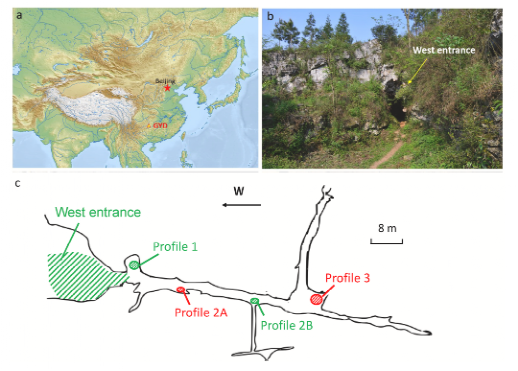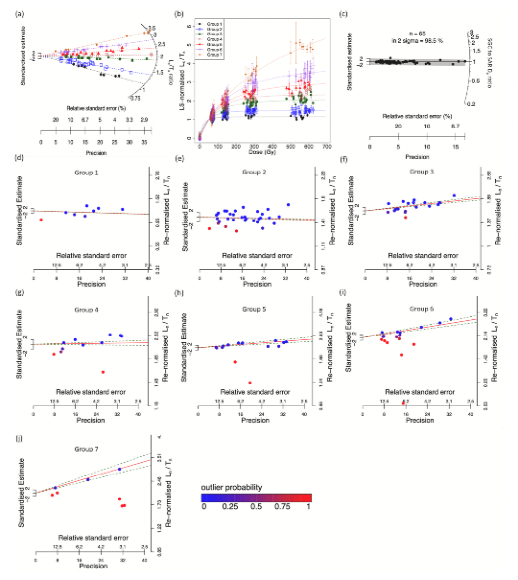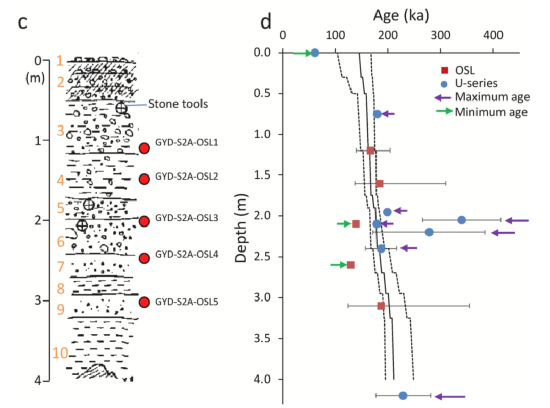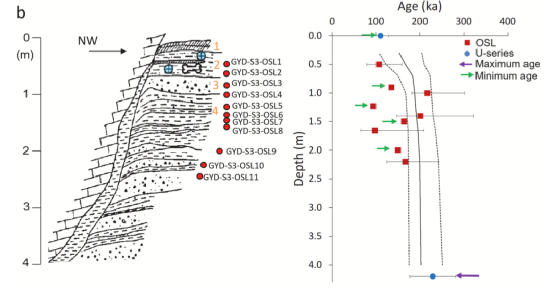The archaeometry team publishes the latest academic achievements in international journals.

Recently, Hu Yue, associate researcher of the Archaeological Dating Laboratory at the Center for Archaeological Science, Sichuan University, published an article entitled "New chronology of the deposits from the inner chambers of the Guanyindong cave, southwestern China" in the international journal "Journal of Archaeological Science".
The Guanyindong site is located in Qianxi City, Guizhou Province, and is a famous Paleolithic site in China. It enjoys the reputation of "Zhoukoudian in the north and Guanyindong in the south" in the academic circle. A 2019 article published in "Nature" magazine used optically stimulated luminescence dating to determine that the burial age of the site's stone tools was divided into two stages, 160,000-170,000 and 80,000-90,000 years ago. Therefore, the time of the earliest Levallois technology production in East Asia was pushed to 170,000 years ago. However, these data only come from two profile samples at the entrance of the cave. Based on this research, this article measured the ages of two excavated profiles (Profile 2A and Profile 3, Figure 1) in the Guanyindong site, thus establishing a complete and reliable chronology for the Guanyindong site.

Figure 1 Location map of Guanyindong site and profiles
Due to the dark quartz particles in the cave sediments, the small number of accepted quartz particles, and the mixing of many young particles, a reliable standard global growth curve (SGC) cannot be established, and traditional age model statistical methods cannot give accurate age estimates. Therefore, this research uses a combination of conventional single-grain LnTn and Bayesian hierarchical age model (BHAM) methods, which not only avoids the underestimation of age caused by the "truncation effect", but also fully considers the sampling position, signal strength, dispersion, curve fitting, dose rate heterogeneity, and other data and corresponding errors of individual particles in the calculation process, and identifies outliers in the sample by setting target groups (Figure 2), so that the age of the sample can be measured more accurately.

Figure 2 Single-grain test and outlier results of sample GYD-S2A-OSL3
In addition, when finalizing the age results, this study also incorporated previous uranium series dating data into the age estimation through OxCal software to provide further age limits for the profile. The final deposition age of Profile 2A was determined to be 248,000-104,000 years ago, and the deposition age of Profile 3 was 251,000-92,000 years ago. The age of stone tools and fossils is 183,000-107,000 years ago (Figures 3 and 4).


Figures 3 and 4 Final age results of Profiles 2A and Profile 3
This research was funded by the National Natural Science Foundation of China and led by the Archaeological Dating Laboratory team of the Center for Archaeological Science, Sichuan University. Cooperative units include Peking University, the Institute of Vertebrate Paleontology and Paleoanthropology of the Chinese Academy of Sciences, and the University of Wollongong, Australia.
The Archaeological Dating Laboratory at the Center for Archaeological Science, Sichuan University can currently perform optically stimulated luminescence dating for Quaternary Paleolithic, Neolithic, and historical sites. The laboratory has a Danish Ris酶 - DA-20 luminescence dating instrument, a German Honle solar simulator, centrifuges, ovens, pure water machines, ultrasonic equipment, etc., and is currently adding Ris酶 - DA-20 luminescence dating instruments, a Polish uDose low-background counter, an ORTEC portable gamma spectrometer, and a planetary ball mill, etc. It can realize the field collection of optically stimulated luminescence samples, sample pretreatment, sample measurement, data processing, and age analysis. By using single-slice and single-grain methods to measure mineral deposition, high-resolution dating of archaeological sites can be achieved to explore human origins and evolution, the development of the Paleolithic, and the migration and exchange of ancient humans. The core team members currently include associate researchers, graduate students, and laboratory technicians.
